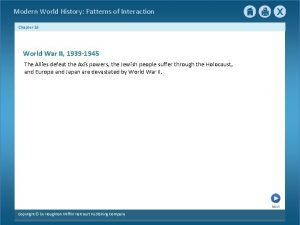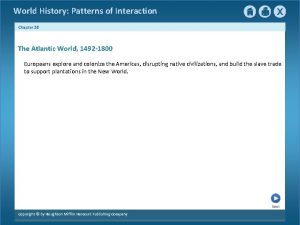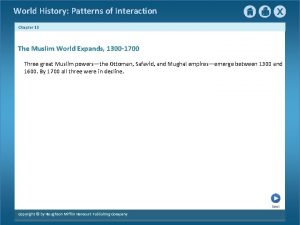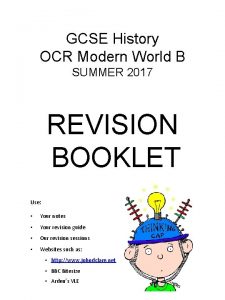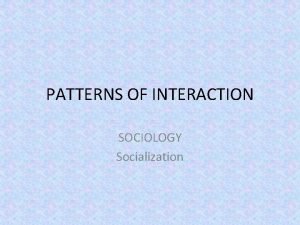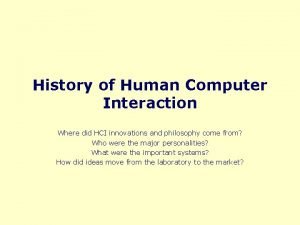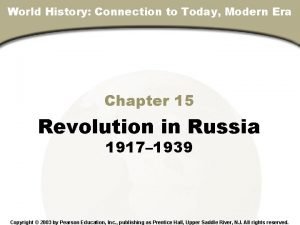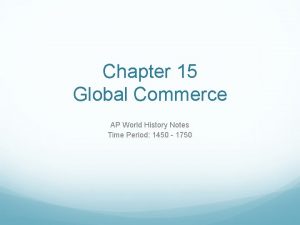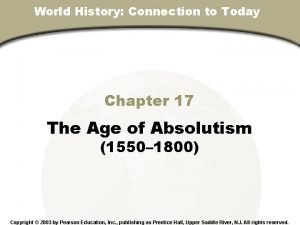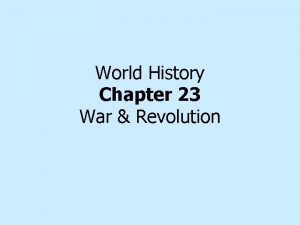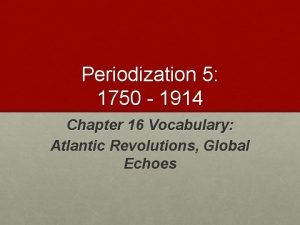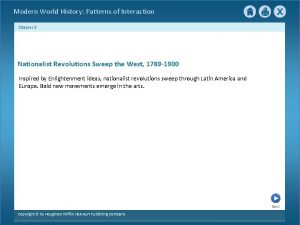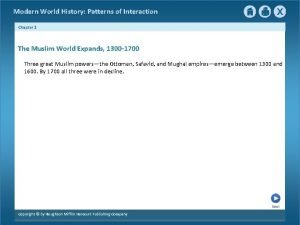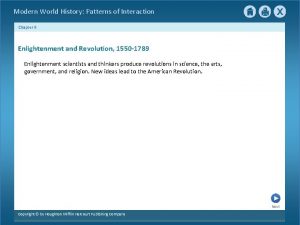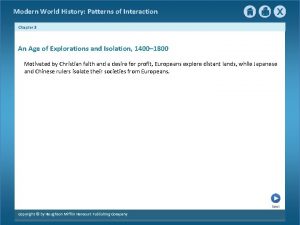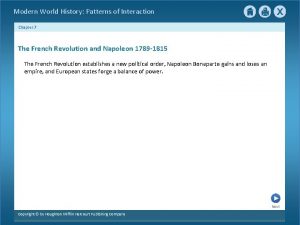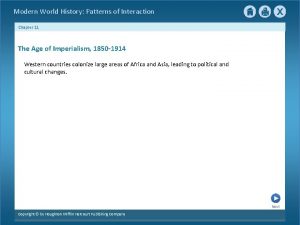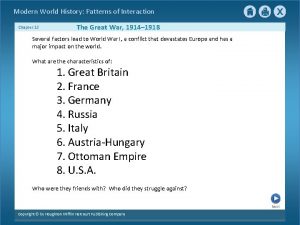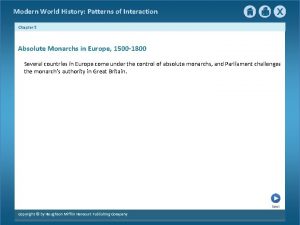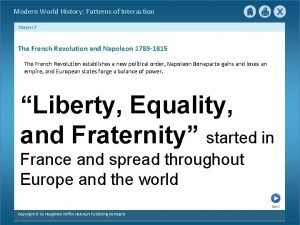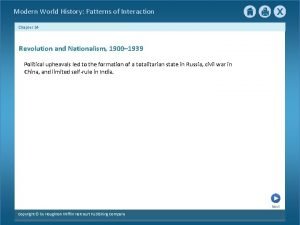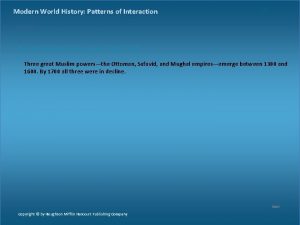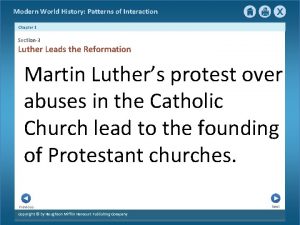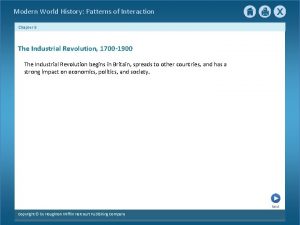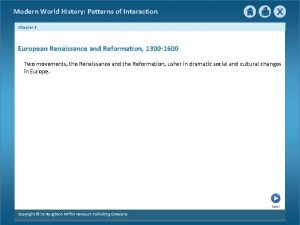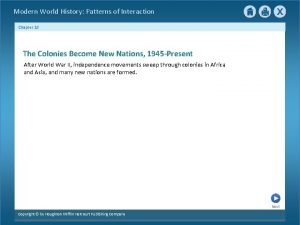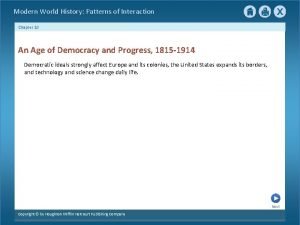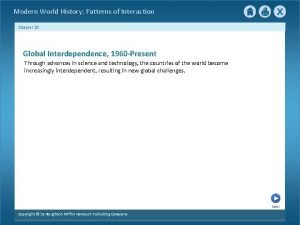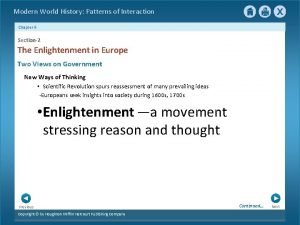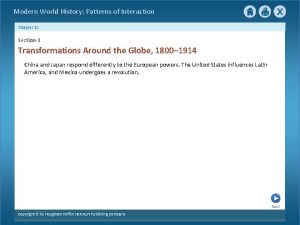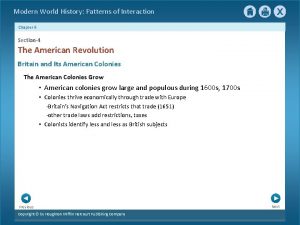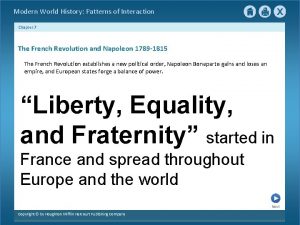Modern World History Patterns of Interaction Chapter 15





























- Slides: 29

Modern World History: Patterns of Interaction Chapter 15 Years of Crisis, 1919– 1939 Societies undergo political, economic, and social changes that lead to renewed aggression. Next Copyright © by Houghton Mifflin Harcourt Publishing Company

Modern World History: Patterns of Interaction Chapter 15 Years of Crisis, 1919– 1939 SECTION 1 Postwar Uncertainty SECTION 2 A Worldwide Depression SECTION 3 Fascism Rises in Europe SECTION 4 Aggressors Invade Nations Previous Copyright © by Houghton Mifflin Harcourt Publishing Company Next

Modern World History: Patterns of Interaction Chapter 15 Section-1 Postwar Uncertainty The postwar period is one of loss and uncertainty but also one of invention, creativity, and new ideas. Previous Copyright © by Houghton Mifflin Harcourt Publishing Company Next

Modern World History: Patterns of Interaction Chapter 15 Section-1 Postwar Uncertainty A New Revolution in Science Impact of Einstein’s Theory of Relativity • Albert Einstein offered radically new ideas in field of physics • Theory of relativity—idea that space and time are not constant • New ideas make world seem more uncertain than before Influence of Freudian Psychology • Sigmund Freud—Austrian doctor with new ideas about the mind • Claims that human behavior is not based on reason Previous Copyright © by Houghton Mifflin Harcourt Publishing Company Next

Modern World History: Patterns of Interaction Chapter 15 Literature in the 1920’s Impact of the War • Suffering caused by World War I leads many to doubt old beliefs Writers Reflect Society’s Concerns • Novels of Kafka reflect uneasiness of postwar years • Novels of Joyce reflect Freud’s ideas about the mind Thinkers React to Uncertainties • Philosophy of existentialism—no universal meaning to life • Friedrich Nietzsche urges return to ancient heroic values Previous Copyright © by Houghton Mifflin Harcourt Publishing Company Next

Modern World History: Patterns of Interaction Chapter 15 Revolution in the Arts Artists Rebel Against Tradition • Artists want to depict inner world of mind • Cubism transforms natural shapes into geometric forms • Surrealism—art movement that links dreams with real life Composers Try New Styles • Composers move away from traditional styles • Jazz—musical style that captures age’s new freedom Previous Copyright © by Houghton Mifflin Harcourt Publishing Company Next

Modern World History: Patterns of Interaction Chapter 15 Society Challenges Convention Women’s Roles Change • Women take on new roles during World War I • This work helps many win the right to vote • In 1920 s, women adopt freer clothing, hairstyles • Some women seek new careers Previous Copyright © by Houghton Mifflin Harcourt Publishing Company Next

Modern World History: Patterns of Interaction Chapter 15 Technological Advances Improve Life The Automobile Alters Society • Cars improve after the war • Cars become less expensive • Increased auto use changes people’s lives Airplanes Transform Travel • Charles Lindbergh is first to fly alone across Atlantic Radio and Movies Dominate Popular Entertainment • In 1920 s, commercial radio stations spread across U. S. • Motion pictures become major industry, art form Previous Copyright © by Houghton Mifflin Harcourt Publishing Company Next

Modern World History: Patterns of Interaction Chapter 15 Section-2 A Worldwide Depression An economic depression in the United States spreads throughout the world and lasts for a decade. Previous Copyright © by Houghton Mifflin Harcourt Publishing Company Next

Modern World History: Patterns of Interaction Chapter 15 Section-2 A Worldwide Depression Postwar Europe Unstable New Democracies • Fall of kingdoms, empires creates new democracies in Europe • People have little experience with representative government • Some form coalition governments—temporary, multi-party alliances • Frequent changes in government create instability Previous Copyright © by Houghton Mifflin Harcourt Publishing Company Next

Modern World History: Patterns of Interaction Chapter 15 The Weimar Republic Democracy in Germany • Weimar Republic—Germany’s democratic government formed in 1919 • Government has serious weaknesses Inflation Causes Crisis in Germany • Value of German currency falls dramatically Attempts at Economic Stability • American loans help revive German economy Efforts at a Lasting Peace • Germany and France sign treaty pledging no more war • Many nations sign a similar agreement, the Kellogg-Briand pact Previous Copyright © by Houghton Mifflin Harcourt Publishing Company Next

Modern World History: Patterns of Interaction Chapter 15 Financial Collapse A Flawed U. S. Economy • Weaknesses in American economy cause serious problems • Wealth is distributed unevenly • Most people are too poor to buy goods produced • Factory owners cut back on production, lay off workers • Farmers produce more food than people can eat • Many farmers cannot repay loans and lose their land Previous Copyright © by Houghton Mifflin Harcourt Publishing Company Continued… Next

Modern World History: Patterns of Interaction Chapter 15 Financial Collapse {continued} The Stock Market Crashes • Stock prices soar • Many people buy stocks on credit • Investors begin selling stocks, which lowers prices • On October 29, 1929, stock market collapses as prices fall very low Previous Copyright © by Houghton Mifflin Harcourt Publishing Company Next

Modern World History: Patterns of Interaction Chapter 15 The Great Depression Economic Downturn • Great Depression—long business slump of 1930 s • Marked by bank failures, loss of savings, unemployment A Global Depression • American economic problems create problems in other countries • World trade falls sharply Effects Throughout the World • Germany and Austria suffer greatly, as do Asia and Latin America Previous Copyright © by Houghton Mifflin Harcourt Publishing Company Next

Modern World History: Patterns of Interaction Chapter 15 The World Confronts the Crisis Britain Takes Steps to Improve Its Economy • British voters elect coalition government, avoids political extremes • Government brings about slow, steady economic recovery • Preserves democracy by avoiding political extremes Previous Copyright © by Houghton Mifflin Harcourt Publishing Company Continued… Next

Modern World History: Patterns of Interaction Chapter 15 The World Confronts the Crisis {continued} France Responds to Economic Crisis • France has more self-sufficient economy • Preserves democracy in spite of economic troubles Socialist Governments Find Solutions • Public works programs help Scandinavian countries recover Recovery in the United States • Franklin D. Roosevelt—American president during Depression • New Deal—Roosevelt’s program of government reform to improve economy Previous Copyright © by Houghton Mifflin Harcourt Publishing Company Next

Modern World History: Patterns of Interaction Chapter 15 Section-3 Fascism Rises in Europe In response to political turmoil and economic crises, Italy and Germany turn to totalitarian dictators. Previous Copyright © by Houghton Mifflin Harcourt Publishing Company Next

Modern World History: Patterns of Interaction Chapter 15 Section-3 Fascism Rises in Europe Fascism’s Rise in Italy New Political Movement • Fascism is new, militant political movement • Emphasizes nationalism and loyalty to authoritarian leader Mussolini Takes Control • Italians want a leader who will take action • Fascist Party leader, Benito Mussolini, promises to rescue Italy • Italian king puts Mussolini in charge of government Il Duce’s Leadership • Mussolini takes firm control of politics and economy in Italy Previous Copyright © by Houghton Mifflin Harcourt Publishing Company Next

Modern World History: Patterns of Interaction Chapter 15 Hitler Rises to Power in Germany A New Power • Adolf Hitler—obscure political figure in 1920 s Germany The Rise of the Nazis • Nazism—German brand of fascism • Hitler becomes Nazi leader, plots to seize national power • Mein Kampf—Hitler‘s book detailing beliefs, goals • Hitler believes that Germany needs lebensraum, or living space • Germans turn to Hitler when economy collapses Previous Copyright © by Houghton Mifflin Harcourt Publishing Company Next

Modern World History: Patterns of Interaction Chapter 15 Hitler Becomes Chancellor Hitler’s New Power • Hitler is named chancellor • Turns Germany into totalitarian state • Uses brutal tactics to eliminate enemies • Nazis take command of economy The Führer Is Supreme • Hitler takes control over every aspect of German life Hitler Makes War on the Jews • Nazis deprive Jews of rights, promote violence against them Previous Copyright © by Houghton Mifflin Harcourt Publishing Company Next

Modern World History: Patterns of Interaction Chapter 15 Other Countries Fall to Dictators World Is Divided • Most of eastern Europe falls to dictators • Only Czechoslovakia retains democratic government • World splits into two camps—democratic and totalitarian Previous Copyright © by Houghton Mifflin Harcourt Publishing Company Next

Modern World History: Patterns of Interaction Chapter 15 Section-4 Aggressors Invade Nations As Germany, Italy, and Japan conquer other countries, the rest of the world does nothing to stop them. Previous Copyright © by Houghton Mifflin Harcourt Publishing Company Next

Modern World History: Patterns of Interaction Chapter 15 Section-4 Aggressors Invade Nations Japan Seeks an Empire Militarists Take Control of Japan • Military leaders take control of country • Want to solve economic problems through foreign expansion Japan Invades Manchuria • Japan has investments in Manchuria, Chinese province • In 1931, Japanese army seizes Manchuria • League of Nations protests action; Japan withdraws from League Japan Invades China • In 1937, Japan launches war on China Previous Copyright © by Houghton Mifflin Harcourt Publishing Company Next

Modern World History: Patterns of Interaction Chapter 15 European Aggressors on the March Mussolini Attacks Ethiopia • In 1935, Mussolini attacks Ethiopia • League of Nations does not stop aggression Hitler Defies Versailles Treaty • In 1935, Hitler begins rebuilding German army • In 1936, Germany occupies Rhineland • Britain urges appeasement, a policy of giving in to aggression • Germany, Italy, and Japan—the Axis Powers—form an alliance Previous Copyright © by Houghton Mifflin Harcourt Publishing Company Continued… Next

Modern World History: Patterns of Interaction Chapter 15 European Aggressors on the March {continued} Civil War Erupts in Spain • In 1931, a republic is declared in Spain • In 1936, General Francisco Franco leads rebellion • Hitler and Mussolini help Franco and his Fascists • In 1939, Franco wins Spanish Civil War • Franco becomes Spain’s Fascist dictator Previous Copyright © by Houghton Mifflin Harcourt Publishing Company Next

Modern World History: Patterns of Interaction Chapter 15 Democratic Nations Try to Preserve Peace United States Follows an Isolationist Policy • Isolationism—avoidance of political ties with other countries • In 1935, Congress passes Neutrality Acts The German Reich Expands • Hitler plans to expand Third Reich—German Empire • In 1938, Hitler annexes Austria • Hitler demands the Sudetenland from Czechoslovakia • Czechs refuse, ask France for help Previous Copyright © by Houghton Mifflin Harcourt Publishing Company Continued… Next

Modern World History: Patterns of Interaction Chapter 15 Democratic Nations Try to Preserve Peace {continued} Britain and France Again Choose Appeasement • Leaders meet at Munich Conference to settle Czech crisis • Britain and France agree to let Hitler take Sudetenland • But in 1939, Hitler still takes rest of Czechoslovakia • Mussolini takes Albania; Hitler demands part of Poland Nazis and Soviets Sign Nonaggression Pact • In 1939, Stalin and Hitler pledge never to attack one another Previous Copyright © by Houghton Mifflin Harcourt Publishing Company Next

Modern World History: Patterns of Interaction Chapter 15 This is the end of the chapter presentation of lecture notes. Click the HOME or EXIT button. Previous Copyright © by Houghton Mifflin Harcourt Publishing Company Next

Modern World History: Patterns of Interaction Chapter 15 Print Slide Show 1. On the File menu, select Print 2. In the pop-up menu, select Microsoft Power. Point If the dialog box does not include this pop-up, continue to step 4 3. In the Print what box, choose the presentation format you want to print: slides, notes, handouts, or outline 4. Click the Print button to print the Power. Point presentation Previous Copyright © by Houghton Mifflin Harcourt Publishing Company Next
 World history patterns of interaction solutions
World history patterns of interaction solutions Chapter 20 section 1 world history
Chapter 20 section 1 world history World history patterns of interaction
World history patterns of interaction World history patterns of interaction
World history patterns of interaction Ap world history chapter 25 africa and the atlantic world
Ap world history chapter 25 africa and the atlantic world History gcse spec
History gcse spec Interaction patterns in group work
Interaction patterns in group work Patterns of interaction sociology
Patterns of interaction sociology Autokinesis
Autokinesis Countries michael jackson visited
Countries michael jackson visited In traditional dating patterns dating behavior
In traditional dating patterns dating behavior Closed patterns and max-patterns
Closed patterns and max-patterns History of hci
History of hci Chapter 17 section 3 world history
Chapter 17 section 3 world history Chapter 32 assessment world history
Chapter 32 assessment world history Chapter 30 section 2 world history
Chapter 30 section 2 world history Chapter 15 section 1 world history
Chapter 15 section 1 world history Mongols chapter 13
Mongols chapter 13 World history chapter 15 section 3
World history chapter 15 section 3 Chapter 15 world history
Chapter 15 world history Chapter 15 ap world history
Chapter 15 ap world history Chapter 17 assessment world history
Chapter 17 assessment world history World history chapter 8 section 1
World history chapter 8 section 1 Chapter 23 section 3 world history
Chapter 23 section 3 world history History alive the ancient world chapter 8
History alive the ancient world chapter 8 Chapter 16 vocab ap world history
Chapter 16 vocab ap world history Chapter 8 section 1 world history
Chapter 8 section 1 world history Chapter 11 ap world history notes
Chapter 11 ap world history notes Chapter 16 section 1 world history
Chapter 16 section 1 world history History alive chapter 14
History alive chapter 14
